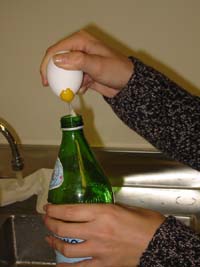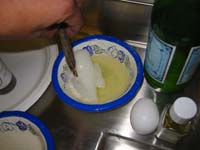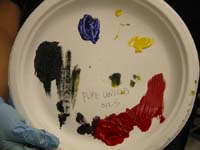|
 Method 1 - Egg Tempera with Stand Linseed Oil Method 1 - Egg Tempera with Stand Linseed Oil
Crack top of one egg and drip entire contents into a small container.
Mix vigorously. Fill the eggshell with each linseed oil and water, add
to egg mixture, mix again to emulsify.
Oily ingredients added is any nonaqueous ingredient which serves as an
emulsifier.
- Generally worked overall. Responded well to gesso.
Method 2 - Egg Tempera with Refined Linseed Oil
Crack top of one egg and drip entire contents into a small container.
Mix vigorously. Fill the eggshell with each linseed oil and water, add
to egg mixture, mix again to emulsify.
- Painted well on plaster, and alright on gesso (with a few coats).
 Method 3 - Egg Tempera with Egg Yolk Only Method 3 - Egg Tempera with Egg Yolk Only
Crack egg and separate yolk from white, discarding the white, and drying
the egg yolk on a paper towel (with egg yolk remaining within protein
skin). Pick up egg yolk and puncture skin, squeezing contents into small
container. Mix a teaspoonful of distilled water, shake to emulsify.
This method is the most ancient of egg temperas. Egg yolk has specific
properties that are utilized in tempera since it contains: albumen, as
emulsifier, egg oil, and lechithin, a fatty substance. Egg-yolk film,
when dried out, becomes insoluble.
- Well on plaster, weak on gesso.
 Method 4 - Egg Tempera with Egg White Only Method 4 - Egg Tempera with Egg White Only
Crack egg and separate yolk from white, saving the white. Beat egg white
until reaches meringue-like consistency, let stand for 8 hours. Protein
parts sink to bottom and forms bottom thick brown pure protein binding
layer. Mix the protein parts with pigment to form paste.
- Fair on plaster, fail on gesso.
 Method 5 - Linseed Oil Only Method 5 - Linseed Oil Only
Mix linseed oil directly with dry or paste pigments.
This method more closely resembles pure oil paintings, but the method
is still considered tempera.
- Strong on plaster, fair on gesso.
Our Evaluation of Paint and Leonardo:
We found that the paint that worked best on gesso was plain linseed oil mixed with pigment paste. The runner-up was linseed oil
mixed with egg and water in equal quantities to form the binding and then mix with paint paste. The worst was mixing egg white with
paint paste (but may be due to inadequate preparation). The plain linseed oil, however, remained tacky and did not dry for days.
Since gesso is more similar to the substance that Leonardo used (Greek pitch), our evaluation is based on the efficacy of painting on
gesso. The descriptions of the failings of the Battle of Anghiari, explain how the paint dripped down the wall, especially when in
contact with heat. This evaluation most closely resembles an increased quantity of egg-mixture over linseed oil (or perhaps even
another non-drying oil). However, one must recall that the size of Leonardo's painting was very large, and thus our smaller, quick drying
paintings make it hard to judge where Leonardo failed due to materials, since his large work probably did not dry as well as our smaller panels did.
|







 Method 1 - Egg Tempera with Stand Linseed Oil
Method 1 - Egg Tempera with Stand Linseed Oil Method 3 - Egg Tempera with Egg Yolk Only
Method 3 - Egg Tempera with Egg Yolk Only Method 4 - Egg Tempera with Egg White Only
Method 4 - Egg Tempera with Egg White Only Method 5 - Linseed Oil Only
Method 5 - Linseed Oil Only